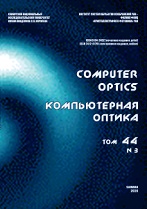|
Эта публикация цитируется в 4 научных статьях (всего в 4 статьях)
ОБРАБОТКА ИЗОБРАЖЕНИЙ, РАСПОЗНАВАНИЕ ОБРАЗОВ
Time-optimal algorithms focused on the search for random pulsed-point sources
A. L. Reznika, A. V. Tuzikovb, A. A. Solovieva, A. V. Torgova, V. A. Kovalevb
a Institute of Automation and Electrometry of the Siberian Branch of the Russian Academy of Sciences, 630090, Novosibirsk, Russia, Academician Koptyug ave. 1
b United Institute of Informatics Problems of the National Academy of Sciences of Belarus, 220012, Belarus, Minsk, Surganova st., 6
Аннотация:
The article describes methods and algorithms related to the analysis of dynamically changing discrete random fields. Time-optimal strategies for the localization of pulsed-point sources having a random spatial distribution and indicating themselves by generating instant delta pulses at random times are proposed. An optimal strategy is a procedure that has a minimum (statistically) average localization time. The search is performed in accordance with the requirements for localization accuracy and is carried out by a system with one or several receiving devices. Along with the predetermined accuracy of localization of a random pulsed-point source, a significant complicating factor of the formulated problem is that the choice of the optimal search procedure is not limited to one-step algorithms that end at the moment of first pulse generation. Moreover, the article shows that even with relatively low requirements for localization accuracy, the time-optimal procedure consists of several steps, and the transition from one step to another occurs at the time of registration of the next pulse by the receiving system. In this case, the situation is acceptable when during the process of optimal search some of the generated pulses are not fixed by the receiving system. The parameters of the optimal search depending on the number of receiving devices and the required accuracy of localization are calculated and described in the paper.
Ключевые слова:
optimal search, pulsed-point source, localization accuracy, receiver.
Поступила в редакцию: 16.02.2019
Принята в печать: 07.03.2019
Образец цитирования:
A. L. Reznik, А. В. Тузиков, А. А. Соловьев, A. V. Torgov, V. A. Kovalev
Образцы ссылок на эту страницу:
https://www.mathnet.ru/rus/co683
|

|




 Обратная связь:
Обратная связь: Пользовательское соглашение
Пользовательское соглашение
 Регистрация посетителей портала
Регистрация посетителей портала Логотипы
Логотипы








 Цитирование в формате
Цитирование в формате 
